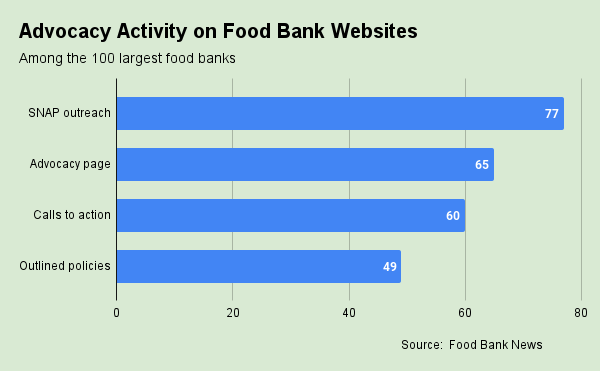There are many ways for food banks to be active in advocacy. Chief among them are regularly communicating with members of Congress and state governments about anti-hunger legislation, as well as engaging the media and partner organizations on policy issues.
The Food Bank News Advocacy Honor Roll looks strictly at the advocacy actions that food banks take on their websites. Because SNAP is by far the most effective tool our nation has to fight hunger, we look for emphasis on SNAP throughout a food bank’s website, not only among its policy initiatives but also as an option for people seeking food assistance. What better way to promote and sustain SNAP but to get more people using it?
Also important is to have a page or a section on the website devoted to advocacy, underscoring for visitors the value of using their voice to promote policies that push against hunger. On the advocacy web page, we look for two specific features. One is a call to action, such as a link to find out more, or sign up for a newsletter, or get involved in an activity, for example. The other is information about specific policy initiatives that the food bank is backing.
Our analysis of the top 100 food bank websites found that 42 food banks are active in all four areas identified as being important to website advocacy, earning them placement on our “High Honor Roll.” Another 17 food banks were found to be active in three of the four, granting them the distinction of “Honor Roll.” (Our findings cover only the website advocacy activities of the 100 largest food banks by revenue, as identified in our 2022 report of the Top 300 Food Banks.)
SNAP outreach emerged as the most common advocacy effort on food bank websites, with 77 of the top 100 food banks having SNAP outreach on their sites. Ideally, information about SNAP – including what it is, who is eligible, and how people can apply – can be easily found in one or two clicks.
A growing number of food banks are including contact forms on their sites so potential SNAP users can request help in completing their applications. Some, including Care and Share Food Bank for Southern Colorado, as well as Feeding Northeast Florida and Feeding Tampa Bay, have put mRelief’s three-minute questionnaire directly on their websites to streamline the process of determining eligibility. mRelief says that it has unlocked $1.2 billion in SNAP benefits by making it easier for people to apply.
Other notable SNAP outreach features include the mini photos that Second Harvest Foodbank of Southern Wisconsin posts of each of its outreach team members. Second Harvest Food Bank of Central Florida has instruction videos that show how to apply for SNAP, while Greater Chicago Food Depository offers an overview of the non-grocery benefits of SNAP. Who knew that SNAP could be used at restaurants (in Illinois), for low-cost internet service, and for museum entry?
Of the top 100 food banks of 2022, just under two-thirds or 65 of them have advocacy pages on their websites. At a time when many food banks are seeking to elevate the voices of people with lived experience of hunger, Food Bank of Contra Costa and Solano (Calif.) does an exemplary job of putting those voices front and center on its advocacy page. The page features videos of community members with lived experience, as well as links to Zoom sessions that capture the passion and drive of the members of the food bank’s Speaker Series (which Food Bank News wrote about here). Tarrant Area Food Bank (Texas) also stands out for having a multitude of well-designed advocacy pages gathered under a single tab devoted to advocacy at the top of its website.
Some food banks have built features into their advocacy pages that seek to speak directly to community members impacted by hunger. Oregon Food Bank, for example, engages community members through a survey that solicits their opinions on how to end hunger. Second Harvest Food Bank of Southern Wisconsin strongly encourages people to vote through its Be A Voter webpage. In a similar vein, Houston Food Bank provides loads of useful information about how and where to vote, as well as a link so people can see whether they’re registered. Manna Food Bank (N.C.) created a video, accessible through its website, on why it’s important to vote.
These encouragements to take a survey or watch a video are just some examples of the calls to action on food bank advocacy pages. Of the top 100 food banks of 2022, 60 included some type of call to action. Highlights include a comprehensive advocacy toolkit from River Bend Food Bank (Iowa) that includes a series of webinars people can watch, as well as sample letters to the editor or congresspeople, and where to send the letters. Feeding Tampa Bay offers a large social media toolkit people can use to share their passion.
Food banks are least likely to outline their specific policy priorities on their advocacy pages, with only 49 of them doing so. Tarrant Area Food Bank bolsters its broad set of policy priorities with fact sheets that offer deep dives into federal, state and farm bill issues. In an uncommon step, Greater Pittsburgh Community Food Bank includes its priorities for tax policies, along with its federal, state and local initiatives. In addition to outlining its policies, Food Lifeline stands out for soliciting and posting the viewpoints of 21 local candidates regarding issues related to hunger. Such a move not only elevates the issue of hunger, but provides valuable information about each candidate’s propensity to take action against it. – Chris Costanzo, with research provided by Nicolas Magrino.
Like what you’re reading?
Support Food Bank News
This article was made possible by the readers who support Food Bank News, a national, editorially independent, nonprofit media organization. Food Bank News is not funded by any government agencies, nor is it part of a larger association or corporation. Your support helps ensure our continued solutions-oriented coverage of best practices in hunger relief. Thank you!
Connect with Us:










